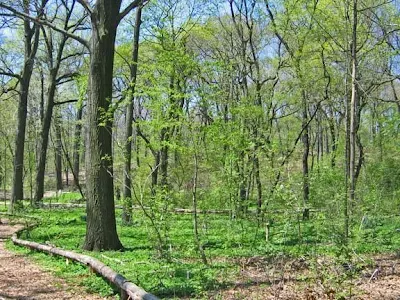Thoughts on a Stroll Through Prospect Park
Last weekend (the hot one, not the wet one) the weather was for sprawling and strolling. So I strolled. All the way to the Farmer's Market to buy ramps, via the Midwood trails.
Prospect Park is amazing in a city filled with really good parks. We've seen a lot of restoration and it looks great. Yet I've always been let down by what I perceive to be lax maintenance and re-construction in the southern end, around the lake. This area is not only my entrance to the park, but one of my favorite places.
A woman pushing a stroller around a large muddy puddle.
The north side of the lake shows a restoration moving forward, defeating the phragmites and restoring plantings along the shore. The remaining perimeter appears unmanaged as we encounter compacted earth, belgian blocks falling into the lake or overwashed by it, trash littering the phragmites colonies, and muddy disintegrating pathways.
The lake sits in a large basin which extends out to the paved park drive. Rain water collects at the pathways. At the base of Lookout Hill there is erosion carrying soil deposits over the roadway. In both areas there needs to be an investment in rebuilding the pathways above grade and re-configuring drainage patterns.
This decrepit staircase leading to the Concert Grove should be fixed. Why has it been like this for years? The under-privileged staircase leads to a really sweet spot in the park that is rather under-used. Why? Disrepair like this is the visual cue that lingering here won't be pleasant. The grove has park benches, seasonal plantings, as the name indicates -large plane trees, a pavilion, and a statue of Abe Lincoln. Yes, thank you ghost of Robert Moses, the woefully ugly Wollman Rink is there as well, but not too visible from the benches.
Walk through the Concert Grove and you may notice the staircase on the left leading up the slope. Take the staircase up and not 50 feet from it you'll find the desire line on the right leading back down to the Concert Grove. Desire lines are a product of poor design and human will. I'm not sure which came first, the staircase or the foot path. Either way, plant in a way that interferes with the desire to avoid the staircase.
As I strolled up the East Drive, I see a family eyeing the Audubon Center. There is black chain link fencing between them and their destination. The horse trail appears to head in the direction they want to go, but they have strollers and are hesitant to get stuck in the gravelly sand. They ask me how to get down there. I tell them to walk up East Drive and they'll see the ramp that allows them down to the Audubon Center. Yet I know that they may be easily confused; it will feel too far as they overshoot their destination, then backtrack.
When people see their destination, yet the designed pathway to it is perceived to be out of the way, people begin to make their own path. The park management response is to create obstacles to this instinct -the chain link fence.

The photo above shows you the entrance to the ramp which takes you to the boathouse, crossing over the horse path, from East Drive. It is a poor solution to the problem, which is this: the Audubon Center is not meant to be approached from the East Drive. This is because the Boat House was built on top of Olmstead's design along with a number of other classical-styled buildings in the park. The McKim, Mead, and White period created a number of "destinations" in the park out of sync with the Olmstead design.

I finally made it to the area known as Midwood. It's been under restoration, and generally looks good.

It has a lacework of trails that can be disorienting to anyone unfamiliar with its meandering. Not a stone's throw away people by the hundreds are sprawled on the grass in barely any clothes paying little attention to those around them. However, in the woods, somewhat wary are the eyes of the few whose paths you cross. The wood isolates, and few bask there as they do the field.

When you come upon the aging Rick's Place sign you feel as if there is a history here you couldn't possibly know. Was he murdered here, did he just hang out here, or both. Maybe he planted trees or watched birds here. The old sign adds to the feeling of stumbling on a ruin, a ruin of one man's habits and preoccupations.
I exit the woods and make my way to the farmer's market at Grand Army Plaza. On my way back, I take to the road.







Nice walk! When I lived at Grand Army Plaza I walked there most weekends and once went on a foraging walk with "Wild Man Steve Brill" there -- a surprising amount of food is growing in the park!
ReplyDeleteI also remember learning that Olmstead designed it so that buildings weren't visible from the park's interior - people have the illusion of being in the country. I noticed that's true for most of your photos, too!